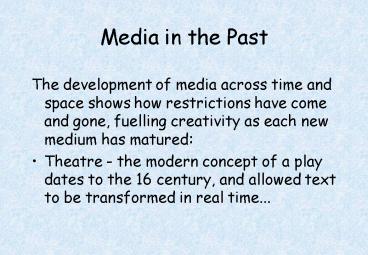Media in the Past - PowerPoint PPT Presentation
1 / 31
Title:
Media in the Past
Description:
QuickTime 2 & 3 (plus MIDI, MPEG, objects, panoramas, interactive ... QuickTime. Movie Trailers. Interactive Objects. Navigable panoramas. Embedded Multimedia ... – PowerPoint PPT presentation
Number of Views:57
Avg rating:3.0/5.0
Title: Media in the Past
1
Media in the Past
- The development of media across time and space
shows how restrictions have come and gone,
fuelling creativity as each new medium has
matured - Theatre - the modern concept of a play dates to
the 16 century, and allowed text to be
transformed in real time...
2
Media in the Past (cont)
- Television - Live broadcasts were the only option
before the 1960s, now they are a rare treat! TV
Plays originally consisted of pointing a camera
at a theatre stage!!!
3
Media in the Past (cont)
- Video - the ability to record broadcasts is 20-30
years old, but we take for granted the ability to
view programmes when we want to, and can cheaply
produce our own material, which lead to
innovations in TVproduction...
4
Media in the Past (cont)
- Computers Cable - We are finally returning to
media that expect or demand us to be there in
real time! - Now, lets look at the
- Present and the Future
5
The Present - Synthetic Characters
Interactive Teletubbies
Microsoft's Barney (!)
Capable of two-way comms with a PC via a radio
interface
http//www.microsoft.com/products/hardware/actimat
es/ http//www.current.org/tech/tech801b.html
6
The Future - Synthetic Characters
SWAMPED! is an interactive experience in which
instrumented plush toys are used as a tangible,
iconic interface for directing autonomous
animated characters. http//characters.www.media.m
it.edu/groups/characters/projects.html
7
The Present - The mobile Internet
http//www.palm.com/
http//www.psion.com/
http//www.nokia.com/
8
The Future - Interaction by Implants
On Monday 24th August 1998, at 400pm, Professor
Kevin Warwick underwent an operation to
surgically implant a silicon chip transponder in
his forearm.
A receiver picking up this signal can be
connected in to an Intelligent Building network.
On picking up the unique, identifying signal, a
computer can operate a range of devices, such as
doors, lights, heaters or even other
computers. What is not mentioned was the pain
involved, and the massive doses of anti-biotics
that were needed to prevent infection!!!
9
Case Study 3D Technologies
Mike Reddy, School of Computing (from an original
lecture designed in conjunction with Geoff
Elliott)
10
3D Technologies - Java
- True platform independent
- Ideal for web as viewed within an applet
- A class library (e.g. Java3D) in development
- Currently labour intensive
- Need to create code from scratch
- Much less intuitive or interactive than VRML
- Java3D is not an accepted standard yet
11
3D Web Technologies -VRML
- Virtual Reality Modelling Language
- VRML 1 3D objects, textures links
- VRML 2 Movable objects, interactivity
- Viewed in Browser (e.g. CosmoPlayer and Netscape)
12
Example VRML
VRML V1.0 ascii Separator Material
ambientColor 0.2 0.2 0.2
diffuseColor 0.8 0.8 0.8
specularColor 0 0 0
emissiveColor 0 0 0 shininess
0.2 transparency 0
Material AsciiText
string "This is a cool demo world!"
spacing 1 justification CENTER width 0
AsciiText Separator
13
VRML in Education
- CollegeNet
- The Student Genome Project
VRML in Business
- Visinet
- Blaxxun Corporation
14
CollegeNet http//www.collegenet.com/vrml/
15
Education - The Student Genome Projecthttp//www.
cat.nyu.edu/sgp/
- MOOs - objective oriented Multi User Domains,
such as Science MOO - A virtual, text-based, multi-user world for
social interaction - Virtual Interaction - multimedia-based meetings,
activities - Implemented in Shockwave, Java and VRML
16
http//www.cat.nyu.edu/sgp/vrml/index.html
17
http//www.cat.nyu.edu/sgp/vrml/index.html
18
http//www.cat.nyu.edu/sgp/vrml/index.html
19
Visinethttp//www.eimc.brad.ac.uk/research/visine
t.html
- Demonstrate collaboration across networks using
3D visualisation systems. - European funded project (4m)
- Achievements
- 10 sites 4 countries
- up to 155 Mbs
- Virtual environment for working
20
http//barny.eimc.brad.ac.uk/visinet/HomePage.htm
l
21
Blaxxunhttp//www.blaxxun.com/vrml
- Create your own virtual worlds
- Share virtual experiences over internet
- Team working, shopping, advertising
- Create you personal Avatar(s)
- 3D or image-based
- automated behaviours and gestures
22
http//www.cybertown.com/main_ieframes.html
23
http//www.blaxxun.com/vrml/home/ccpro.htm
24
http//www.blaxxun.com/vrml/home/ccpro2.htm
25
Creating Avatars
- Complete object must fit within 1-2 m
- Origin (0,0,0) in head
- One texture and 500 Polygons allowed
26
Creating Avatars (cont)
- Programmable Gestures defined
- Yes/No - Smile/Laugh/Grin - Hello/Goodbye
27
Useful Urls for VRML
- http//www.web3d.org/vrml/vrml.htm
- http//hiwaay.net/crispen/vrml/index.html
- http//funsan.biomed.mcgill.ca/warrick/
- masters/publications/CMBEC22/slideshow/
28
3D Technologies -QuickTime http//www.apple.com/q
uicktime/
- Viewed in Browser (e.g. QuickTime Plug-in and
Netscape). - QuickTime 1 Simple video and audio.
- QuickTime 2 3 (plus MIDI, MPEG, objects,
panoramas, interactive hotspots, URL aware,
hybrid file types. - QuickTime 4 (plus Streamed media, Scripted
interactivity, Flash, MP3, etc).
29
QuickTime
- Movie Trailers
- Interactive Objects
- Navigable panoramas
- Embedded Multimedia
30
Useful URLs for QuickTime
http//www.comp.glam.ac.uk/pages/staff/mreddy/qtvr
/ http//www.apple.com/quicktime/ http//wrinklein
time.org/ http//www.armchair-travel.com/
31
Where to look for changing standards?
The W3C (World Wide Web Consortium) was founded
in October 1994 to lead the World Wide Web to its
full potential by developing common protocols
that promote its evolution and ensure its
interoperability. The Consortium is led by Tim
Berners-Lee, creator of the World Wide Web, and
Jean-François Abramatic. http//www.w3.org/











![❤[PDF]⚡ Engaging the Past: Mass Culture and the Production of Historical Knowledge PowerPoint PPT Presentation](https://s3.amazonaws.com/images.powershow.com/10049553.th0.jpg?_=20240607032)




![❤[PDF]⚡ History, Disrupted: How Social Media and the World Wide Web Have Changed the PowerPoint PPT Presentation](https://s3.amazonaws.com/images.powershow.com/10045025.th0.jpg?_=202406010512)
![❤[PDF]⚡ History, Disrupted: How Social Media and the World Wide Web Have Changed the PowerPoint PPT Presentation](https://s3.amazonaws.com/images.powershow.com/10043987.th0.jpg?_=20240531073)













